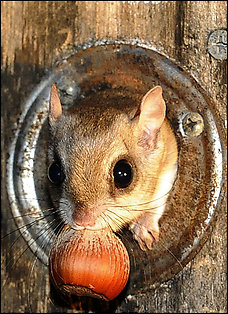
A flying squirrel retrieves food put out by the staff at Long Branch Nature Center in Arlington County.
Richard A. Lipski, The Washington Post
Interestingly, each oak tree undergoes a 2-4 year cycle: sometimes it produces lots of acorns, sometimes few. But I don't see any way for the cycles to synchronize in an area as large as the whole East Coast, and I don't believe this has been observed. So, something mysterious is happening. I don't like it. There are too many weird die-offs going on: bees, bats, frogs, and so on.

On a lighter note: Greg Egan reports a story about "Israeli spy pigeons":
BTW, I don't know if you remember that I'd planned to visit the city of Kashan in Iran, but ended up dropping it from my itinerary because I lost two days due to a delayed flight. On the weekend, a friend told me that the Iranian authorities had "arrested Israeli spy pigeons" at the nuclear site near Kashan! I thought he must have got the story from The Onion, but it turned out to be true ... or at least it was published in an Iranian reformist newspaper, so maybe they actually had their tongue in their cheek as much as the editors of The Onion do:I wrote about the long-lived reign of pigeon technology on July 30th. Pigeons were the fastest method of sending long-distance messages from 2900 BC to 1844 AD! They played a crucial role in the Franco-Prussian war. But I'd never heard of spy pigeons before.
- Iran arrests 'spy pigeons' near uranium plant, The Australian, October 21, 2008.
Sheer ignorance on my part: pigeons were used to carry spy cameras over enemy lines in WWII. They looked pretty cute:
Finally, here's a charming email I received in response to my October 30th entry about the Iranian city of Yazd:
Hi,
I was reading your book Gauge Fields, Knots and Gravity - J. Baez, J. Muniain. I said to myself, "Whose is this sweet pen opening the knots of this difficult subject? Let me find him on the Internet!" I have a djvu copy of your book torrented into my computer. When I got to your place, I saw some familiar pictures. I became gobsmacked. You also liked me: pictures from Iran and Yazd. I am originally from Yazd. You called that place, "cool!" Do you know why I like maths and quantum mechanics and other things? People of Yazd are very hard working. My father was a great lawyer, a legislator and a famous judge of highest rank in Iran. He also was a disciple of existentialism school of philosophy of Molla Sadra (1570-1648). Modern followers of this philosopher believe that he in his (existential) evolutional motion of essence attributed to the matter essentially has introduced the time dimension of Einstein's relativity. From that point they became very interested in studying the relativity theory. My father was also one of them. After being fifty years old he started reading Bertrand Russell's ABC of Relativity and such things. At the law school they were not taught any mathematics, and his familiarity was only of some basic maths and geometry. So he decided to learn all about differentials and integrals in a hope to understand tensors. One night he came with Gamov's book One, Two, Three,... Infinity and he talked about everything from that book including the worm in the apple and making a human inside-out, having all the universe inside him. At that time he was fifty eight and he died in 1960 when he was fifty nine years old. So it became my adventure to continue his road. Now, I am fifty-seven and have just got to understand your book. Let me tell you some stories about Yazdi people to let you know how much they liked green world and recycling. Their qanat system shows how much they were fighting with the lack of water sometimes they had qanat bringing water as far as 250 miles away. It is a joke that if around Yazd somebody in the empty remote desert sits to make himself lighter suddenly a shovel comes under him and a voice with the accent of the Yazdi people (it's like the Liverpool accent in Britain) tells him, "Don't waste it!" They have to keep the land fertile to fight back the moving dunes. It is believed that when Cyrus the Great was going from Shiraz to Bacteria to fight nomads attacking Iran he was passing Yazd and all the way his army riding in almond forests. But inner lakes receded and only small thickets and gardens of almonds remained that people were keeping with difficulties. Their baklava made of almonds is the sweet memory of those forests.
All the best and good luck
Yanis Hakeem (UK citizen)
Here's a timeline loosely taken from this paper:
Chondrites are stony meteorites that formed early in the history of the solar system. They're made of chondrules — millimeter-sized spheres of olivine, pyroxene and other minerals — together with CAIs (calcium-aluminum rich inclusions) and other stuff. These chondrules began life as molten droplets back when the Sun was a T Tauri star, heated only by gravitational collapse.
The Hadean eon began with a bang: the event that formed the moon around 4.55 billion years ago! The currently popular explanation of this event is the giant impact theory, sometimes called Big Splat Theory. The idea is that a planet about the size of Mars occupying one of the Lagrange points of Earth's orbit gradually drifted out of this stable location and eventually smacked into the Earth. This hypothetical doomed planet goes by the name of Theia. You can watch a simulation of it hitting Earth. Ouch!
Whatever caused it, Earth's crust and outer mantle were melted by this event. No rocks on Earth are known to survive from before 4.03 billion years ago, so the details of this time period are greatly debated. However, many igneous rocks, especially basalt (composed mainly of plagioclase and pyroxene) must have been formed at this time.
In the Paleoarchean and Mesoarchean eras, plate tectonics as we know it began. A key aspect of this process is the recycling of the Earth's crust through subduction: oceanic plates slide under continental plates and get pushed into the mantle. Another feature is underwater volcanism and hydrothermal activity.
The earliest hints of life include some banded iron formations that date back 3.85 billion years. The real fun starts with the rise of photosynthesis leading up to the Great Oxidation Event about 2.5 billion years ago. But organisms from the domain Archea can do well in a wide variety of extreme environments without oxygen, and as the name suggests, many of these organisms are very ancient. These organisms gave rise to an active sulfur cycle and deposits of sulfate ores starting in the Paleoarchean era. They also made the atmosophere increasingly rich in methane throughout the Mesoarchean and Neoarchean.
The Archean eon ended and the Proterozoic began with the Great Oxidation Event 2.5 billion years ago. In this event, also known as the Oxygen Catastrophe, photosynthesis put enough oxygen into the atmosphere to make it lethal to most organisms of the time. The oyxgen-rich atmosphere in turn led to a wide variety of new minerals.
In the Mesoproterozoic era, increased oxygen levels in the ocean put an end to many anoxic life forms. For example, around 1.85 billion years ago, banded iron formations suddenly ceased. The next gigayear was rather static and dull — if you're mainly interested in new minerals, that is.
The Neoproterozoic era probably saw several Snowball Earth events: episodes of runaway glaciation during which most or all the Earth was covered with ice. Since ice reflects sunlight, making the Earth even colder, it's easy to guess how this runaway feedback might happen. The interesting questions are why this feedback doesn't happen now — and how it stopped back then!
Here's a currently popular answer to the second question. Ice sheets slow down the weathering of rock. Weathering of rock is one of the main long-term processes that use up atmospheric carbon dioxide, by converting it into various carbonate minerals. On the other hand, even on an ice-covered Earth, volcanic activity would keep putting CO2 into the atmosphere. So, eventually CO2 would build up, and the greenhouse effect would warm things up again. This process might be very dramatic, with perhaps as much as 13% of the atmosphere being carbon dioxide (350 times what we see today), and temperatures soaring to 50 Celsius! But, the details are still the subject of much controversy.
At the end of these glacial cycles, it's believed that oxygen increased from 2% of the atmosphere to 15%. This may be why multi-celled oxygen-breathing organisms date back to this time. Others argue that the "freeze-fry" cycle imposed tremendous evolutionary pressure on life and led to the rise of multicellular organisms.
The Phanerozoic eon, beginning with the Cambrian 540 million years ago, marks the rise of of life as we know it. During this time, sea life has given rise to extensive deposits of biominerals such as calcite, aragonite, dolomite, hydroxylapatite, and opal. There has also been increased production of clay and many different types of soil.
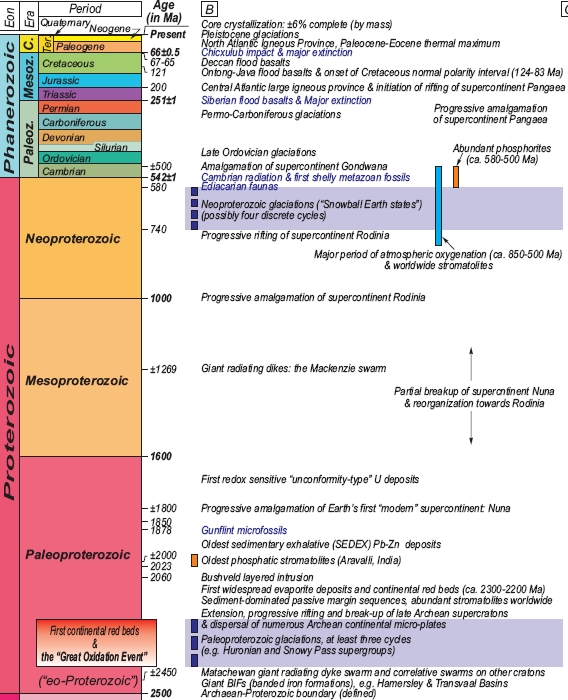
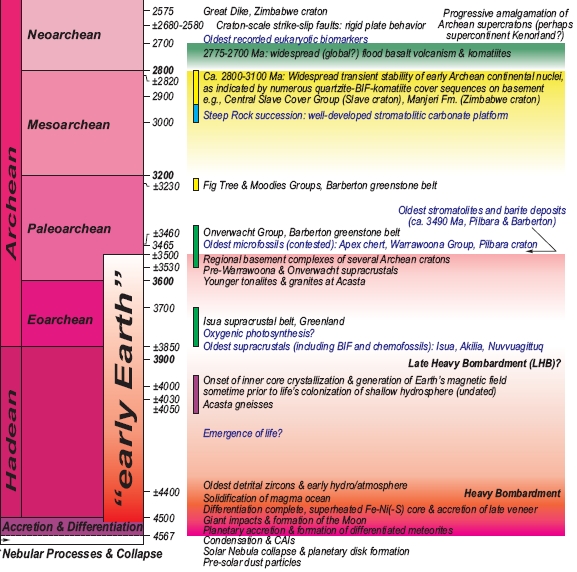
There are lots of cool things to learn about lurking in this chart: the Late Heavy Bombardment, dike swarms, the Slave craton and Archean supercratons, and those supercontinents with wonderful names like Kenorland, Nuna (also called Columbia), and Rodinia.
For a more polished version of the above story, see week273. I also added some of this inforation to my timeline.
In the future, various kinds of human trash will give rise to
new species of minerals. You've already seen glass and styrofoam pellets
on the beach, and huge landfills. A lot of this trash looks ugly
now, but maybe time will beautify it... the glass already looks
pretty.
December 8, 2008
Another sign of the economic crisis:
the Tribune Company, which owns the Chicago Tribune, the
Los Angeles Times and nine other newspapers,
filed for bankruptcy today. They have
$13 billion of debts and assets of only $7.6 billion.
I quit taking the LA Times on August 24th — the management had run the paper into
the ground. I didn't expect it to go under so soon.
Indeed, the LA Times made $100 million in profits this year.
But it seems
Sam Zell's risky business strategies are part of the
problem: they made him lots of money when times were good, but now he's in
trouble.
December 12, 2008
I woke up to a phone call — my mother. I thought
she said my father had died: I yelled out to Lisa, "Dad's dead!"
But after some explanation it turned out he was alive. He had
caught a virus that was running around the nursing home where lives,
even though they'd locked down the place to prevent its spread:
my mother wasn't able to visit him last Sunday, because of this
quarantine. His blood pressure was extremely low: 60 over 30.
They gave him a few hours to live.
I guess I haven't written about my father here since June 13, 2006. He's been in a nursing home ever since a serious illness laid him up in the hospital in the summer of 2007. His health has slowly deteriorated since then, though he certainly had plenty of good days. He stopped using a walker and started using a wheelchair. His memory gradually became worse. A few months ago he got a bad case of pneumonia and could barely breathe; they gave him oxygen. A recent checkup of his implanted defibrillator showed he'd had another heart attack at 7 in the morning a few weeks ago — he didn't recall this, so maybe it happened when he was asleep. He had more and more trouble doing the simplest things. Last week he called my mom at 3 am and asked her if it was day or night. Later she showed him how to open the blinds to look outside. All this has been very sad, so I feel a lot of the grief has already been squeezed out of me, though there's probably more somewhere.
Later I called my mom at the nursing home. She and my sister Alex
had been visiting my father. Sometimes he was asleep, sometimes
awake: when they arrived he said "What's up, girls?"
By the end of their long vigil, the nurse said my dad might pull through.
December 13, 2008
I tried calling my mother but she wasn't available —
she's never taken to cell phones. Around 11 am, while Lisa and I were
in the middle of our usual shopping routine, having breakfast at a
cafe near Trader Joe's, she called me. She had visited my
father again; the nurse said he was somewhat better. She was
back home, tired, and wanted a nap.
At dinner my mother called and told me my father had died. Shortly before midnight (back east) she'd been woken by a phone call with this news.
It turned out that at 5 pm, she'd been struck with an urge to visit my dad again. She drove over to the nursing home. He was in bed with his shirt pulled off, dripping in sweat. He asked her to massage his chest. As she did, he winced and said "Goudzie, Goudzie..." That was his nickname for her, since her maiden name was Goudzwaard. And those may have been his last words.
She wondered if he'd had another heart attack. She stayed for a
long time, until he fell asleep. She asked the nurse if he
should be transferred to a hospice. The nurse said to call
about it on Monday. But there's no need now.
December 14, 2008
I talked to my mom and sister on the phone, took a hike
with Lisa in the hills behind campus, and finished writing
week273, which I dedicated
to my father. It was a nice excuse to think about what he
was like back when he was healthy, and all the cool things he did.
I wrote:
I'd like to dedicate this issue of This Week's Finds to my father, Peter Baez, who died yesterday around midnight at the age of 87. His health had been failing for a long time, so this did not come as a shock. It's a curious coincidence that I was already writing an issue about minerals, since my dad majored in chemistry and returned to school for a master's in soil science after serving in the Army in World War II. After that he worked in the Blackfeet Nation in Browning Montana, riding around in a jeep, digging up soil samples, and testing them back at the lab for the Army Corps of Engineers. When he found "medicine wheels" - stone circles laid down by the native Americans for ritual reasons - he would report them to his friend the archeologist Tom Kehoe. Later he moved to California, became an editor for the Forest Service, and met my mother.He got me interested in science at an early age because he was always taking me to museums, bringing me books from the public library, and so on. As a little kid, when I spilled something, he'd say "So you don't believe in the law of gravity?" He liked to joke around. Whenever I said an ungrammatical sentence, he'd tease me for it. "I'm not that hungry." "What do you mean? You're not how hungry?"
I learned a lot of math, physics and chemistry from his 1947 edition of the CRC Handbook of Chemistry and Physics - an edition so old that it listed "mesothorium" among the radioactive isotopes. He brought home the book "From Frege to Gödel" — a sourcebook in mathematical logic — because it was in the math section of the library and he misread "Gödel" as "Googol": he knew I liked large numbers! I didn't understand much of it, but it had a big effect on me.
I owe a lot to him.
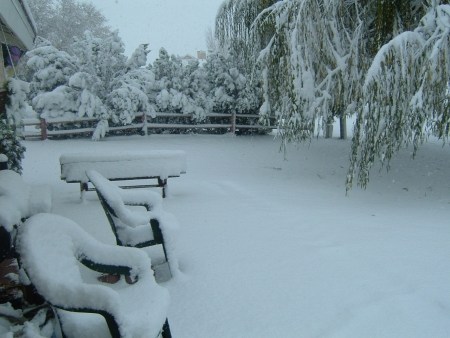
When the clouds clear I'll have to go look at the mountains: by now
they have several feet of snow. Maybe I'll even drive up there when
the roads are cleared.
December 18, 2008
In Iraq, the reporter Muntader al-Zaidi flung his shoes at
Bush, shouting "This is a gift from the Iraqis, this is the farewell kiss,
you dog!....This is from the widows, the orphans and those who
were killed in Iraq!"
Nobody knows how many Iraqis have died violent deaths since Bush led the invasion of Iraq based on false claims of "weapons of mass destruction": estimates range from 86,000 to 151,000 to 1,033,000.
It has been pointed out that if a journalist had thrown a shoe at Saddam Hussein, he and his family would have been tortured and killed. That's true. Al-Zaidi seems to have been beaten, but he probably won't be killed, and I hope his family is okay. It's a bit sad when we need to reach to a notorious dictator to find a comparison that makes Bush look good. We can only hope that Iraq someday winds up a better place than it was.
Here's a graphic from Harper's Magazine illustrating the 10-trillion-dollar bill Bush racked up during the two terms of his presidency. Click on the link for more details.
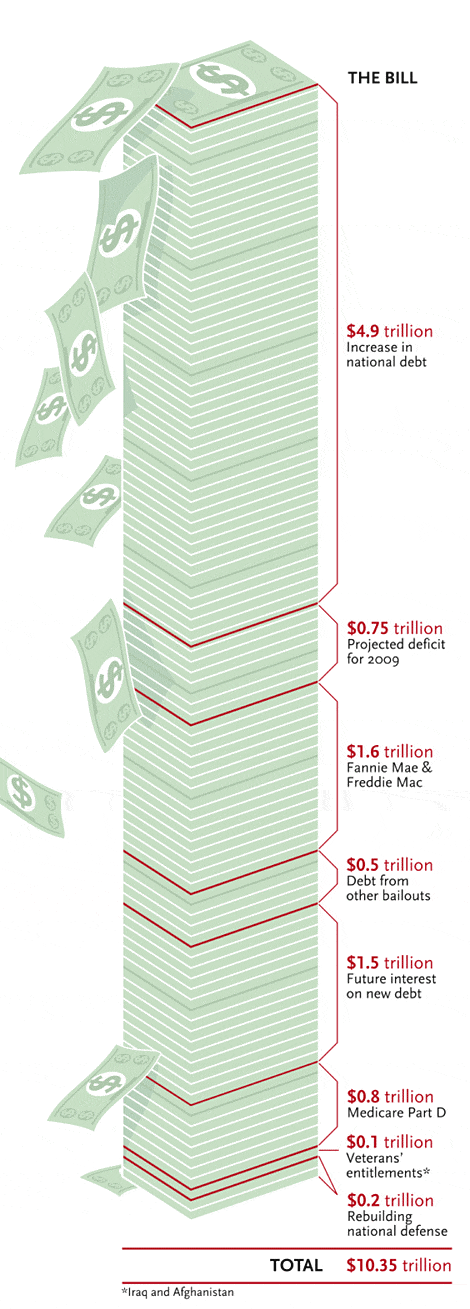
Obama has his work cut out for him. And not just when it comes to the economy: last Thursday, December 11th, Bush's Secretary of the Department of the Interior, Dirk Kempthorne, announced some new rules. He eliminated 35-year-old regulations in the Endangered Species Act that required an independent scientific review of federal projects to determine their effect on protected plants and animals. And, he allowed oil and gas drilling in polar bear habitat off Alaska's coast — a move designed to prevent the Endangered Species Act from being used to regulate greenhouse gas emissions.
These are just a few of Bush's last-minute regulatory moves — over 90 of them! Today Stephen Johnson, head of the Environmental "Protection" Agency, issued a memo saying that carbon dioxide is not a pollutant that needs to be considered when approving new power plants.
You can play an
online game to see
more of Bush's "midnight rules".
December 19, 2008
The clouds have cleared, so we can see the snowy
mountains rising above the smog of San Bernardino:
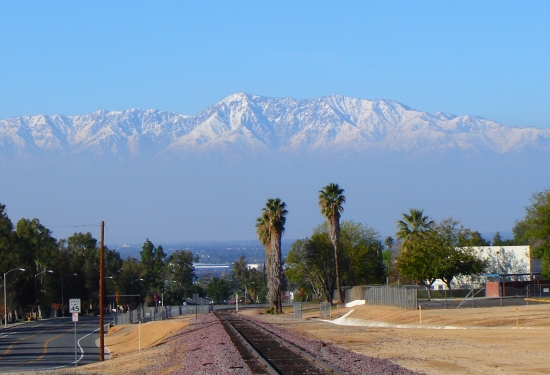
It's beautiful here, but there's icy weather in the midwest and northeast of the country, and the news is not good.
After years of growing fat and stupid making lots of money on inefficient monster vehicles, the US auto industry was felled by the one-two punch of soaring oil prices followed by the collapse of the US economy. Gas is cheap again — I bought some for $1.85 today, and it was cheaper than that last week. But that's just because so many people are going broke — it's not making Americans want to buy more gas-guzzling SUVs, at least not yet. So now the Big Three automakers are begging for money from the US government. Today President Bush announced a $13.4 billion bailout plan for General Motors and Chrysler. Chrysler is taking an extended Christmas vacation, closing all its plants at least until January 19th.
I actually think it might be good, in the long term, if we let the auto companies fail. Lots of jobs would be lost, so it would be very painful for many people in the short term. But the US needs to move in a new direction, and the collapse of the auto industry could be history's way of telling us that certain dinosaurs are headed for extinction.
Another big company filed for bankruptcy today:
Polaroid. Long past its heyday,
crushed by the unexpected rise of digital cameras, Polaroid is by
now owned by the "Petters Group" — whose founder,
the entrepreneur Tom Petters, was accused of swindling and arrested
in October, caught while he was preparing to flee in a yacht
filled with bags of cash.
December 20, 2008
My sister Alexandra sent me this obituary which she is preparing for
the local papers:
Peter Baez, who worked for the USDA Forest Service for 25 years before retiring in 1994, died on Dec. 13 at the Inova Cameron Glen Care Center in Reston. He was 87 years old.An obituary of this sort, like the dehydrated remains of man's life, doesn't really say anything about what he was like.Mr. Baez moved to the Washington area in 1964. He was born in Puebla, Mexico and grew up in Brooklyn, New York. His brother, the physicist Dr. Albert Baez, was the father of singer Joan Baez. Mr. Baez received his B.A. degree from Drew University and then served with the Air Transport Command in the China-Burma-India Theater during World War II. After this, he earned a B.S. degree in soils from Cornell University and an M.S. in soils from the University of Minnesota, Minneapolis.
Mr. Baez worked as a soil scientist with the Bureau of Indian Affairs on two Indian reservations and afterwards, as an engineering technician with the U.S. Corps of Engineers. He then took a civilian editorial position with the U.S. Navy and later held editorial positions with the USDA Office of Information, the Agricultural Research Service, and the USDA Forest Service.
After retiring from Federal service, Mr. Baez volunteered for the Forest Service for three years. Subsequently, he volunteered as an ESL tutor in a county program for about two years. Finally, he volunteered as on ombudsman at the Inova Cameron Glen Care Center in Reston for four and a half years.
Survivors include his wife of 49 years, Phyllis Baez, of Great Falls, VA, his son, John Baez, of Riverside, CA, and his daughter, Alexandra Baez, of Alexandria, VA.
For example, it says "Mr. Baez worked as a soil scientist with the Bureau of Indian Affairs on two Indian reservations."
But, it doesn't say that while working in the Blackfeet Reservation near Browning Montana my dad lived in a shack, cooked using laboratory glassware, built stereo speakers into a door for good resonance, and received a gift of buffalo meat from some native American friends on Christmas... or that he and his friends had to drive 50 miles to the town of Cut Bank to get a drink.
Nor does it say that he later moved to the Colorado River Indian Reservation in Poston: a tiny town in Arizona that had been an internment camp for Japanese Americans during World War II... or that he quit his job in disgust after complaining about how his bosses discriminated against a Jewish colleague and friend of his.
And these anecdotes, too, are just a pale shadow of a man's daily life.
December 22, 2008
Some good news: grownups will soon be running US science policy.
Barack Obama appointed Nobel laureate physicist Steven Chu as head of the Department of Energy. On May 9, 2007, Chu said "If I were emperor, I would put the pedal to the floor on energy efficiency and conservation." As director of the Lawrence Berkeley National Laboratory, Chu pushed scientists to develop technologies to reduce greenhouse gas emissions.
Obama appointed Macarthur prizewinner and Woods Hole director John Holdren to be his science advisor. Holdren recently compared our current approach to climate change to:
In the October issue of Scientific American, Holdren wrote:
Unfortunately, the Bush administration has wasted the last eight years. It should have been taking decisive action but engaged instead in systematic understatement of the danger: it has made ridiculous assertions that the U.S. should not do anything that China does not agree to do and has stubbornly insisted that no action should be taken to improve climate change 'if it hurts the economy.' This last rationalization translates into 'if it costs anybody any money' and is roughly akin to saying that the country should not defend itself against terrorism because that costs money.He recently gave this speech at Harvard:
Obama has also appointed Macarthur prize winner and zoology professor Jane Lubchenco to head NOAA, the National Oceanic and Atmospheric Administration, which does most of the US government research on climate change, and regulates fisheries.
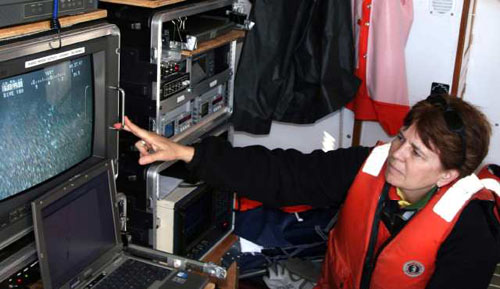
Over time, many, many ecologists observed that the systems they were studying were changing before their very eyes. Ecologists that would go back to the same places year after year after year started seeing changes that had not been documented before. The changes were different, they were happening faster, and many more ecologists began to take note of "how is it changing," and "why is it changing," not just "how does it work?" The next sort of step in that process was "what are the consequences of these changes," not just to the ecosystems but to the people who depend on them, and finally, "how can we do a better job of managing activities that are causing the changes, or of mitigating the changes that are underway?" And so, over the thirty years that I've been a practicing scientist, there has been a real revolution in the nature of the questions that ecologists have been asking of the world, driven in part by larger-scale changes that they were observing.As part of this revolution, she helped propose Sustainable Biosphere Initiative. I hope that at NOAA she can start to implement some of these ideas. The oceans, in particular, are under a double assault by climate change and overfishing. She writes:
Fisheries peaked in the mid 80's and have been on the decline since then. This represents, in part, the sequential depletion of one fishery after another, after another. We also have data suggesting that 90% of all the big fish of the ocean are gone. The huge tuna, sharks, swordfish, marlin, and other icons of the sea have been very significantly depleted primarily by industrial-scale fishing over the last couple of decades.There are major changes underway in oceans. In addition to that, more and more ocean ecosystems are undergoing very rapid, abrupt change. They are complex, nonlinear systems that are characterized by tipping-points, and we're seeing very rapid changes, loss of resilience in these systems, loss of ability to cope with changes, and in fact very radical change as a result.
Empty-handed I entered the world
Barefoot I leave it.
My coming, my going -
Two simple happenings
That got entangled. - Kozan Ichikyo, 1360.
© 2008 John Baez
baez@math.removethis.ucr.andthis.edu